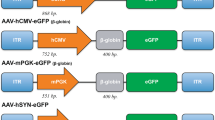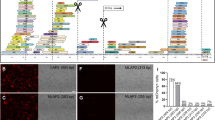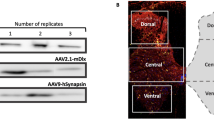Abstract
Recombinant adeno-associated viruses (rAAVs) can transduce several tissues, including the brain. However, in brain the duration of gene expression in different areas is variable, which has been ascribed to viral (CMV) promoter silencing in some regions over time. We have compared expression of enhanced green fluorescent protein (EGFP) in the nigrostriatal pathway of rats mediated by rAAVs containing the CMV or platelet-derived growth factor-β chain (PDGF-β) promoter. In addition, we studied the effects of the woodchuck hepatitis virus post-transcriptional regulatory element (WPRE) on transgene expression in vivo. The rAAV vectors containing the neuron-specific PDGF-β chain promoter transduced significantly more dopaminergic neurons than titer-matched vectors carrying the CMV promoter. Moreover, the WPRE further increased EGFP expression, and a rAAV vector incorporating both the PDGF-β chain promoter and the WPRE resulted in efficient EGFP expression in dopaminergic neurons and their projections in the striatum for at least 41 weeks after virus injection. Our results emphasize the importance of a strong tissue-specific promoter in achieving optimal transgene expression, not only in long-term but also in short-term studies where viral titers may be limiting. Furthermore, they suggest that incorporation of the WPRE into rAAVs, and possibly other types of vectors, is useful to enhance transgene expression in vivo.
This is a preview of subscription content, access via your institution
Access options
Subscribe to this journal
Receive 12 print issues and online access
$259.00 per year
only $21.58 per issue
Buy this article
- Purchase on Springer Link
- Instant access to full article PDF
Prices may be subject to local taxes which are calculated during checkout





Similar content being viewed by others
References
Rabinowitz JE, Samulski J . Adeno-associated virus expression systems for gene transfer Curr Opin Biotechnol 1998 9: 470–475
Büeler H . Adeno-associated viral vectors for gene transfer and gene therapy Biol Chem 1999 380: 613–622
Xiao X, Li J, Samulski RJ . Efficient long-term gene transfer into muscle tissue of immunocompetent mice by adeno-associated virus vector J Virol 1996 70: 8098–8108
Flannery JG et al. Efficient photoreceptor-targeted gene expression in vivo by recombinant adeno-associated virus Proc Natl Acad Sci USA 1997 94: 6916–6921
Mandel RJ, Spratt SK, Snyder RO, Leff SE . Midbrain injection of recombinant adeno-associated virus encoding rat glial cell line-derived neurotrophic factor protects nigral neurons in a progressive 6-hydroxydopamine-induced degeneration model of Parkinson's disease in rats Proc Natl Acad Sci USA 1997 94: 14083–14088
Snyder RO et al. Persistent and therapeutic concentrations of human factor IX in mice after hepatic gene transfer of recombinant AAV vectors Nat Genet 1997 16: 270–276
During MJ et al. In vivo expression of therapeutic human genes for dopamine production in the caudates of MPTP-treated monkeys using an AAV vector Gene Therapy 1998 5: 820–827
Herzog RW et al. Long-term correction of canine hemophilia B by gene transfer of blood coagulation factor IX mediated by adeno-associated viral vector Nature Med 1999 5: 56–63
Jooss K, Yang Y, Fisher KJ, Wilson JM . Transduction of dendritic cells by DNA viral vectors directs the immune response to transgene products in muscle fibers J Virol 1998 72: 4212–4223
Brockstedt DG, Podsakoff GM, Fong L, Kurtzman G, Mueller-Ruchholtz W, Engleman EG . Induction of immunity to antigens expressed by recombinant adeno-associated virus depends on the route of administration Clin Immunol 1999 92: 67–75
Bartlett JS, Samulski RJ, McCown TJ . Selective and rapid uptake of adeno-associated virus type 2 in brain Hum Gene Ther 1998 9: 1181–1186
Mandel RJ et al. Characterization of intrastriatal recombinant adeno-associated virus-mediated gene transfer of human tyrosine hydroxylase and human GTP-cyclohydrolase I in a rat model of Parkinson's disease J Neurosci 1998 18: 4271–4284
McCown TJ et al. Differential and persistent expression patterns of CNS gene transfer by an adeno-associated virus (AAV) vector Brain Res 1996 713: 99–107
Klein RL et al. Neuron-specific transduction in the rat septohippocampal or nigrostriatal pathway by recombinant adeno-associated virus vectors Exp Neurol 1998 150: 183–194
Klein RL et al. Long-term actions of vector-derived nerve growth factor or brain-derived neurotrophic factor on choline acetyltransferase and Trk receptor levels in the adult rat basal forebrain Neuroscience 1999 90: 815–821
Donello JE, Loeb JE, Hope TJ . Woodchuck hepatitis virus contains a tripartite posttranscriptional regulatory element J Virol 1998 72: 5085–5092
Zufferey R, Donello JE, Trono D, Hope TJ . Woodchuck hepatitis virus posttranscriptional regulatory element enhances expression of transgenes delivered by retroviral vectors J Virol 1999 73: 2886–2892
Loeb JE et al. Enhanced expression of transgenes from adeno-associated virus vectors with the woodchuck hepatitis virus posttranscriptional regulatory element: implications for gene therapy Hum Gene Ther 1999 10: 2295–2305
Sasahara M et al. PDGF B-chain in neurons of the central nervous system, posterior pituitary, and in a transgenic model Cell 1991 64: 217–227
Douglas R, Kellaway L, Mintz M, van Wageningen G . The crossed nigrostriatal projection decussates in the ventral tegmental decussation Brain Res 1987 418: 111–121
Xiao X, Li J, McCown TJ, Samulski RJ . Gene transfer by adeno-associated virus vectors into the central nervous system Exp Neurol 1997 144: 113–124
Szczypka MS et al. Viral gene delivery selectively restores feeding and prevents lethality of dopamine-deficient mice Neuron 1999 22: 167–178
Kaplitt MG et al. Long-term gene expression and phenotypic correction using adeno-associated virus vectors in the mammalian brain Nat Genet 1994 8: 148–154
Prosch S et al. Inactivation of the very strong HCMV immediate early promoter by DNA CpG methylation in vitro Biol Chem 1996 377: 195–201
Loser P, Jennings GS, Strauss M, Sandig V . Reactivation of the previously silenced cytomegalovirus major immediate–early promoter in the mouse liver: involvement of NFkappaB J Virol 1998 72: 180–190
Games D et al. Alzheimer-type neuropathology in transgenic mice overexpressing V717F beta-amyloid precursor protein Nature 1995 373: 523–527
Peel AL et al. Efficient transduction of green fluorescent protein in spinal cord neurons using adeno-associated virus vectors containing cell type-specific promoters Gene Therapy 1997 4: 16–24
Samulski RJ, Chang LS, Shenk T . Helper-free stocks of recombinant adeno-associated viruses: normal integration does not require viral gene expression J Virol 1989 63: 3822–3828
Snyder RO, Xiao X, Samulski RJ . Production of recombinant adeno-associated viral vectors. In: Dracopoli NC et al (eds) Current Protocols in Human Genetics John Wiley & Sons 1997 pp . 12.1.1–12.1.20.
Acknowledgements
We thank S Furler for counting neurons and acknowledge I Allmann for providing rats. We are grateful to S Hemmi and Z Dong for critically reading the manuscript, to F Ochsenbein for preparing figures and to A Gentilini and L Bordoli for help with statistical analysis. This work was supported by grants of the Swiss National Science Foundation 31-044449.95 and 31-046648.96 to HB.
Author information
Authors and Affiliations
Rights and permissions
About this article
Cite this article
Paterna, JC., Moccetti, T., Mura, A. et al. Influence of promoter and WHV post-transcriptional regulatory element on AAV-mediated transgene expression in the rat brain. Gene Ther 7, 1304–1311 (2000). https://doi.org/10.1038/sj.gt.3301221
Received:
Accepted:
Published:
Issue Date:
DOI: https://doi.org/10.1038/sj.gt.3301221
Keywords
This article is cited by
-
Improving adeno-associated viral (AAV) vector-mediated transgene expression in retinal ganglion cells: comparison of five promoters
Gene Therapy (2023)
-
Functional expression of complement factor I following AAV-mediated gene delivery in the retina of mice and human cells
Gene Therapy (2021)
-
Optimization of adeno-associated viral vector-mediated transduction of the corticospinal tract: comparison of four promoters
Gene Therapy (2021)
-
Plasmid DNA gene therapy of the Niemann-Pick C1 mouse with transferrin receptor-targeted Trojan horse liposomes
Scientific Reports (2020)
-
Focused Update on AAV-Based Gene Therapy Clinical Trials for Inherited Retinal Degeneration
BioDrugs (2020)



